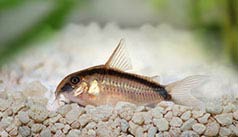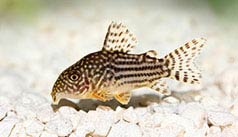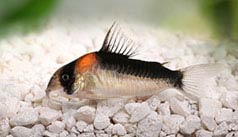

Panda catfish
(Corydoras panda)
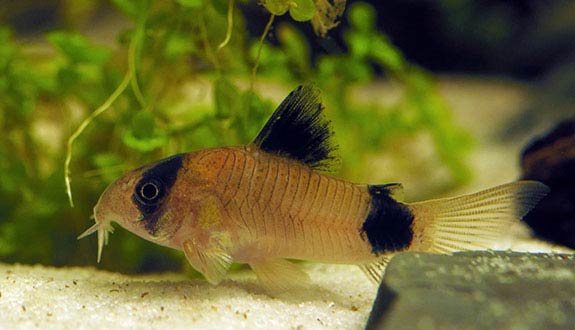
Thanks to Kyllian. As stated by Horlack's scientific article
> read
Alternative species (click on the thumbnail to see the card)
Names
Scientific name
Corydoras panda
Common name
Panda catfish
Panda corydoras
Origin

Origin: South America, Peru and Ecuador
Biotope: Amazonian
Dimorphisml
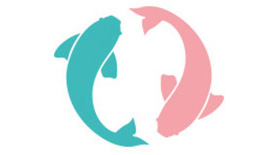
Once adult, the female is larger, wider and taller than the male
Group
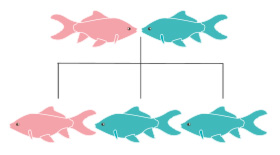
Callichthyidae
Volume

80 L / 18 imp gal / 21 US gal
Parameters

T°: 20 to 25°C or 68 to 77°F
pH: 6 to 7
Hardness: 5 to 15°dGH
Difficulty

Easy
Size

4 to 6 cm (1.6 to 2.4")
Longevity

3 to 5 years
Living zone
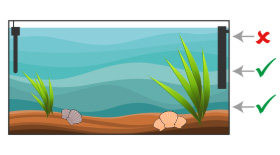
Middle and depth
Individuals

6
Food
How to feed this Corydoras?
Food
How to feed this Corydoras?
Like the other Corydoras, it is omnivorous. It will be satisfied with flakes or pellets sold commercially, but the bottom pellets will be particularly adapted to its mode of feeding: only at the bottom of the aquarium!
t is important to vary your food so that it does not have any deficiencies. Offer it infusoria, artemia, daphnia, krill... A vegetal part is also necessary, like slices of zucchini or cucumber, salad or poached spinach for example.
Pay attention to the quantity of food distributed in order not to pollute the water of your tank. As adults, Corydoras will be satisfied with one meal a day.
If your fish are hungry, they are not eating enough! >If your Corydoras are struggling to eat because other fish in the aquarium are faster, distribute their meal when the lights go out and watch if your Corydoras eat well.
ip: Do you want to make your Corydoras happy? Give them live or frozen bloodworms from time to time, it will have the same effect as fast food on children! It's also very fun to watch!
Behavior
What kind of behavior does this Corydoras have?
Behavior
What kind of behavior does this Corydoras have?
Like many of its cousins, the Corydoras panda alternates intense activity phases (rather evening and morning) with well-deserved rest periods!
If your Corydoras are completely inactive during the day, it may be due to a problem of cohabitation (other species intimidate them), a too small number of individuals, an unsuitable aquarium or a current too weak. Check these points and you will see your Corydoras activate even during the day!
It spends a lot of time rummaging around the floor of your aquarium in search of food. You will observe that it uses small barbs for that. It is also because of these "whiskers" that Corydoras are called "catfish". You will see from time to time your Corydoras panda rise to the surface to ingest a bubble of air. According to several experts, this behavior is completely natural. It allows the Corydoras to supplement their bodies with oxygen when the need arises.
It also likes to have fun, in the current, in the middle part of the aquarium, as well as along the windows (when no other species intimidates him).
Even if the corydoras are very fearful, you can, with gentleness and patience, accustom them to your presence. For this, you must always make very slow and very calm gestures. When your corydoras do not flee you, it denotes a level of fulfilment, security and confidence well above normal!
Cohabitation
Who can live with this Corydoras?
Cohabitation
Who can live with this Corydoras?
In the wild, Corydoras panda always moves along with several hundred individuals. It is therefore necessary to breed a minimum this instinct, called "gregarious" in an aquarium. For this, the Corydoras panda will need the presence of at least 5 individuals of its kind; but the more there is, the better! If the Corydoras group is large enough, individuals are more likely to breed, feel safer, feel comfortable in their aquarium, do not hide, and even "play" together by pulling up the current coming out of the tank. Finally, you will get a behavior very close to the wild, and your fish will be happy to live! Regarding this point, it is estimated that:
group of 6 to 8 individuals: strict minimum
group of 9 to 13 individuals: correct viability
group of more than 14 individuals: behavior similar to natural
Be careful however, a Corydoras panda and a Corydoras aeneus do not recognize themselves as being of the same species and will not associate in a shoal. This is an example but this principle is valid for all species of Corydoras.

Never introduce other bottom species with Corydoras. Indeed, it could stress the small Corydoras who can be shy against territorial and aggressive species that share the same area of life that they do. In addition, food competition will be very strong and still at the expense of the Corydoras.
Choose very quiet roommates because Corydoras are easily intimidated by species that are too bright or too big. It cohabits easily with the other fish of the Amazonian biotope living in the same geographical area as him, such as the Ember Tetra will make perfect roommates.
Note, however, that we must avoid too much food competition in the area of the bottom. It will be preferable that the Corydoras be the only species of this zone of the aquarium, and avoid Loaches and Plecos.
Small useful info: shrimp will live safely together with our nice catfish, even the smallest and youngest. The latter do not risk anything. So you can perfectly combine Panda Corydoras with Neocaridina Davidii (like the Red Cherry for example).
Breeding
How to breed this Corydoras?
Breeding
How to breed this Corydoras?
First, it is important to recognize the sexual dimorphism of Corydoras panda to ensure that reproduction within your group is possible. This can be difficult before adulthood. Note that at sexual maturity, the female is larger, taller and slightly wider than the male. The optimum age for breeding your corydoras is around 3/4 years old. Note that the older a female is, the higher the thickness of the eggs. They are thus more resistant and have a better chance of success, considerably increasing the number of fry. Before this age, you can get some fry all the same. If you want to make your corydoras breed, you understand the importance of installing them from the beginning in a suitable and well maintained aquarium, in order for them to live as long as possible, for a regular and successful breeding in quantity and in quality! To guarantee a greater possibility of spawning, feed them with bloodworms for a few days.
In their natural environment, Corydoras panda breed during the rainy season. The rainwater then slightly changes the water parameters and thus causes the breedings. In the aquarium, simulate the same conditions, thanks to important water changes. Use new water with the same parameters as the aquarium water, but slightly colder. This should trigger spawning in a few days.
You will then see the males harass the females and present their abdomens until the female chooses the lucky one. For the coupling, male and female adopts the so-called "T" position in which the female absorbs the milt of the male in its mouth.
After that, the female lays the eggs under a leaf. It is also a specificity of this species: the female generally chooses leaves as laying supports, and more rarely stones, roots or panes.
The incubation lasts from 3 to 5 days. At birth, the fry look like larvae, very different from the appearance of their parents!
If you leave the fry in your community aquarium, be sure to provide a high plant cover as well as Java moss to allow the young to be able to hide from the predators (the other fish). The Java moss will also serve as a food store because the infusoria grow easily (introduce the Java moss shortly before the breedings for this last point to be valid). The fry will also feed on food and algae.
To have more chance to have surviving fry, it will be advisable to have an aquarium specially dedicated to raising young (a tray of 20 liters / 4 imp gal / 5 US gal may be enough). Fill this aquarium with water from the main tank to have the same water parameters, and set up hiding places (the fry are very fearful and will need to feel safe to grow serenely). You do not have to put a substrate (a bare bottom will even allow you to clean more efficiently). Finally, remove the eggs from the main aquarium and introduce them into the breeding tank. After the fry are born, clean the soil and change the water regularly.
Fry growth can be quite irregular, but they do not eat each other.
When some are big enough and no longer hide, you can put them back in the main aquarium so that they finish growing in a larger volume.
Fry food: infusoria, Artemia nauplies, crumbled dry flakes.
Its aquarium
Which aquarium for this Corydoras?
Its aquarium
Which aquarium for this Corydoras?
In general, two parameters are essential for the Corydoras aquarium: a non-cutting substrate and good filtration generating current.
Firstly the soil: it is imperative to use very fine gravel or sand (like beach sand). Indeed, it was discovered in early 2018 that sand played a key role in the oral hygiene of Corydoras. In addition, by swallowing this sand at full speed and spitting it by their gills in order to look for food, the Corydoras get rid of any parasites that could be fatal to them. It is imperative to avoid sharp ground like quartz, which damages the barbels of your fish, and is going to mutilate them completely.
Then the current: more than the length of the facade, it is especially the current that is important in an aquarium for Corydoras. Indeed, they are excellent swimmers and are... athletes! So, steer a strong current on the "middle" area of the aquarium, leave the bottom and the surface with a little less current. You will see your Corydoras feast on going swimming against the current in this area (if no other species intimidates them)! For everyone to rest, lower the intensity of the current during the night or stop it.
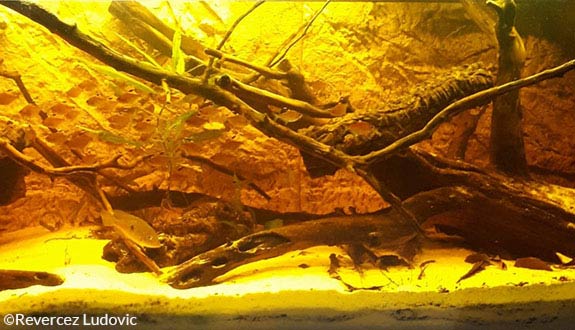
As for decoration, if you want to recreate the natural environment of the Corydoras Adolfoi and promote its well-being, create a decoration with driftwood roots that will form beautiful hiding places and do not plant too much. You can add alder fruits and dried leaves to the aquarium, which will have a nice natural effect (you will have to renew them before they rot). You can leave on a proportion of 50 to 80% of sand beaches essential for the search, 30 to 40% of wood and 10 to 20% of plants. If your fish are comfortable in your aquarium, they will not hesitate to move. A Corydoras that does not swim is a fish uncomfortable in its environment.
For plants, choose sturdy plants with slow growth and broad leaves. As fertilizer is strongly discouraged in an aquarium in Corydoras, opt for plants that do not require this type of feed.
Whatever your choices in terms of layout, still keep enough sandy beach to Corydoras so they can search the substrate.
Corydoras are quite sensitive to water pollution. Make water changes of 10 to 20% of the volume per week.
Good To know
Find all additional information!
Good To know
Find all additional information!
There are over 200 species of Corydoras! Moreover, it should be noted a risk of hybridization between Corydoras of the same line.
Corydoras are often considered "cleaners". It is true that they are scavengers but they will never replace the work of the aquarist! For example, it does not eat their excrement or that of other fish. Thus, these fish are often bought for "practical" purposes (which remains questionable) to the detriment of their well-being. But you will understand, the Corydoras are nice fish that deserve all your attention!
Corydoras Panda has no scales, which makes it particularly sensitive to salt, chemicals and drugs. This also requires maintenance, clean water and stabilized parameters (do not introduce Corydoras in immature aquariums). IT IS NOT RECOMMENDED TO PUT FERTILIZER in a container containing Corydoras. If you notice signs of stress, such as fast breathing and then lethargy (stay still, sometimes near the surface), immediately change 50% of the water (provide a good water conditioner). Be careful, the new water must have the same parameters as the tank, including the temperature. If you isolate your sick fish, it may wilt even faster. Try to stick the hospital tray to the main aquarium so that the sick Corydoras can see its congeners.
Like all Corydoras, this species is able to swallow an air bubble on the surface. Indeed, it is a kind of "intestinal" breathing that allows the fish to supplement its oxygen supply when necessary.
Its barbels are used to search the ground for food. It is because of these «whiskers» that Corydoras are called «catfish».
Corydoras are capable of killing a human in exceptional conditions. Pay close attention to their backbones or pectorals! Depending on the species, they have hemotoxic toxins, hepatotoxic toxins, neurotoxic, etc. Did you know that they do not have a natural predator? It is thanks to this weapon with which they are able to kill their assailant in a very virulent way. Even the piranhas refuse to attack the corydoras! Here is a small zoom on their dorsal or pectoral spines:
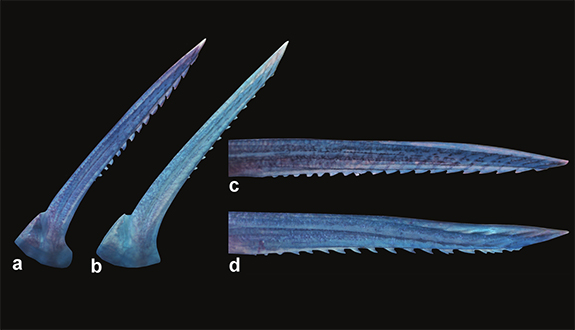
As you can see, in the case of a sting, it is impossible to remove the real sting, it’s like a real harpoon. In addition, the corydoras injects at this time a maximum dose of toxins. Rest assured, the corydoras are very much scared, so it is rare that a situation of deadly contact happens. Most of the time, they will flee for such a situation to happen. But be careful when you put your hands in the water!
Use a large mesh net to prevent stuck in it.
Note the recent appearance of a new variant of this species, the New Corydoras Panda (CW051):

Yours photos!

By Encyclo-Caro

By Encyclo-Caro

By Encyclo-Caro

By Encyclo-Caro

By Encyclo-Caro

By Encyclo-Caro

By Encyclo-Caro
Comments
Sort by:
Please login to post comments
